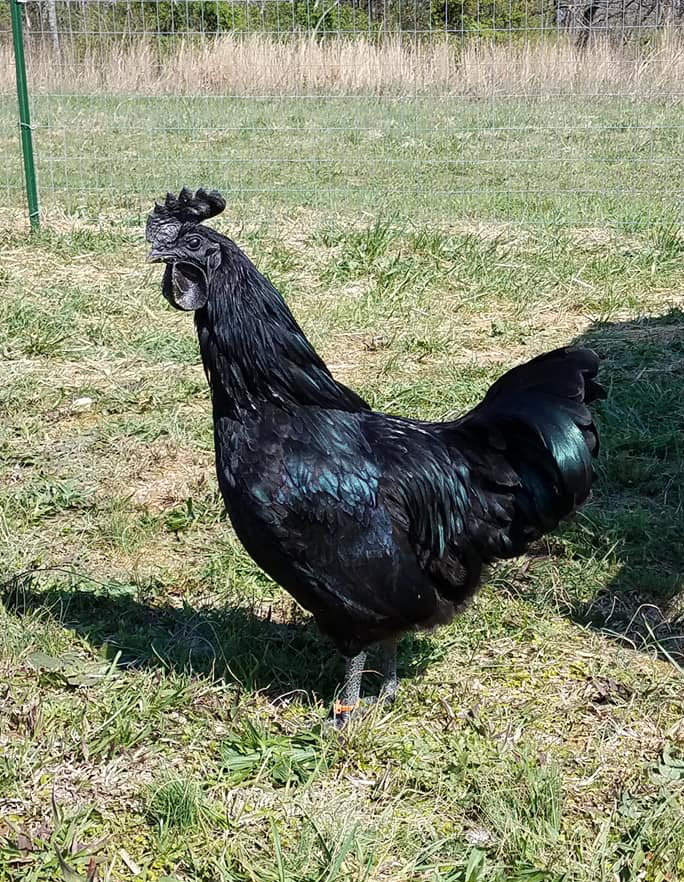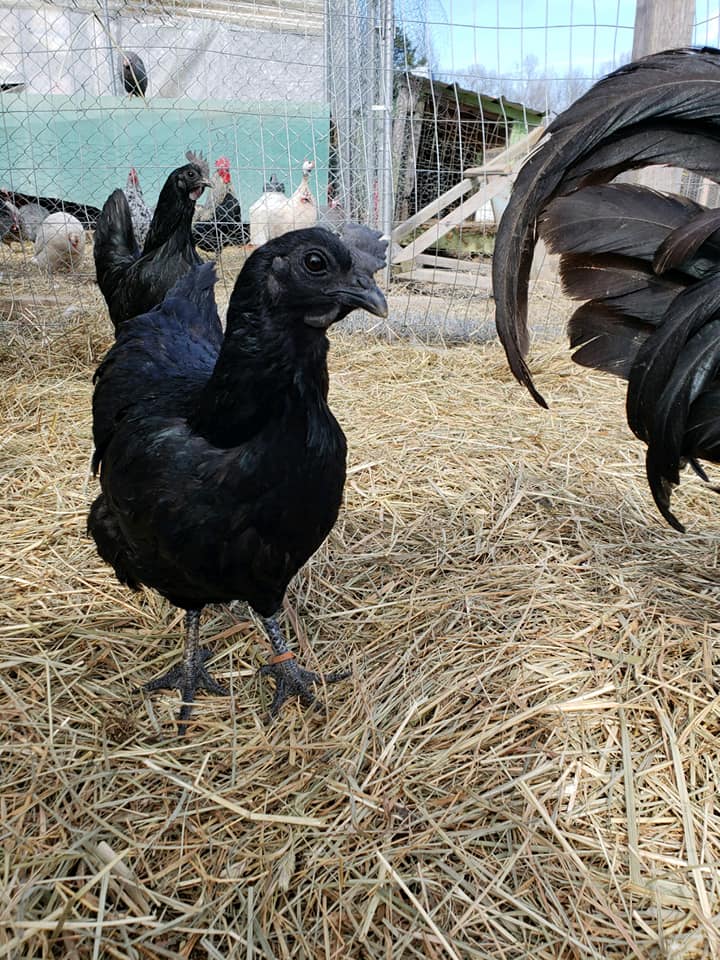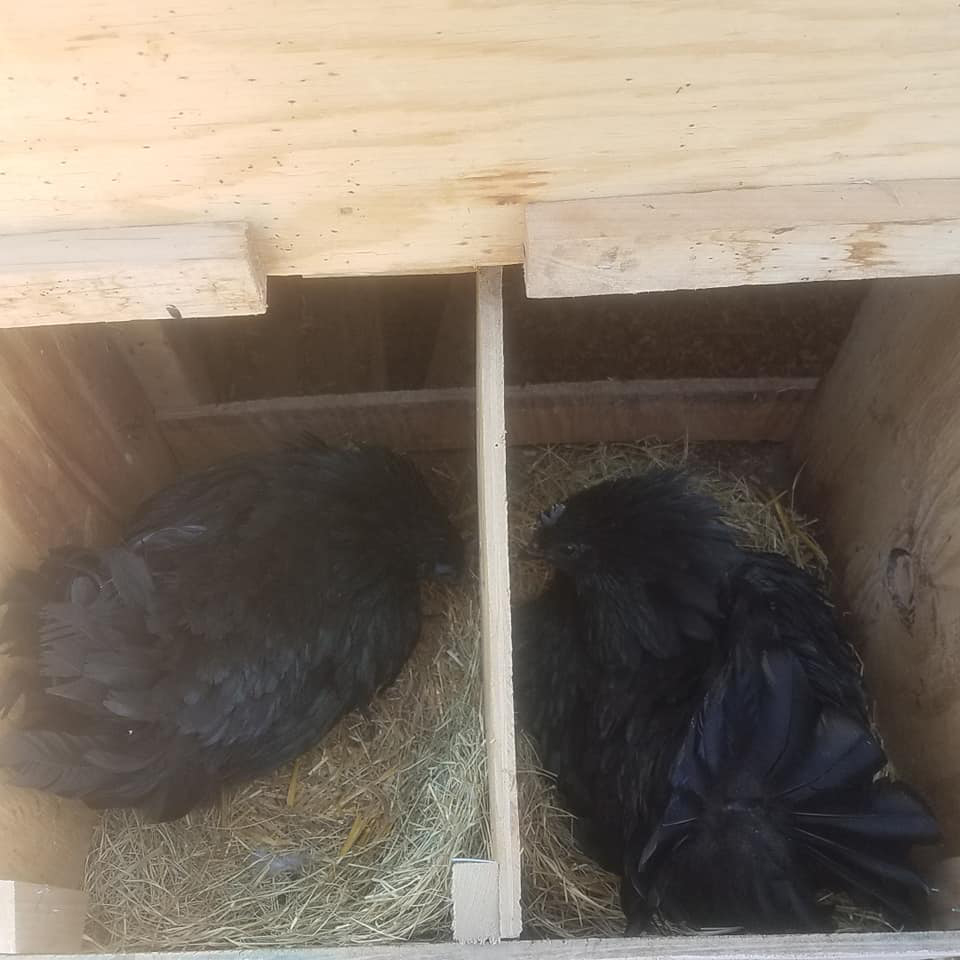Marissa Buchanan raises and breeds these rare, solid black chickens. She shares her experiences of owning a flock and the need to conserve this breed.

Ayam Cemani hen from Marissa’s flock. Photo by author.
Modern History of the Breed
The rare and unique Ayam cemani is revered by poultry enthusiasts. With its black feathers, skin, and flesh, this breed is quite distinctive and certainly worthy of conservation. This uncommon breed is relatively modern, and probably a genetic mutation from the Ayam kedu, a black chicken with red comb and wattles. Both come from islands in Indonesia and, in fact, the word “ayam” means “chicken” in Indonesian. The Ayam cemani may also be a genetic relative of a similar all-black chicken from India: the Kadaknath. Like the Kadaknath and the Ayam bekisar chicken (another Indonesian subspecies of the kedu), the Ayam cemani has a dominant gene that causes dermal hyperpigmentation, known as fibromelanosis. These chickens are entirely black, inside and out. Their eggs, however, aren’t black, but are rather a white-to-cream color. Without careful conservation and breeding practices, the Ayam cemani are currently bred to be completely black without any white pigmentation on feathers, crests, nails or beaks. Without a careful selective breeding program, Ayam cemani owners will likely see their birds to revert back to their kedu predecessors who are not absolutely black.

Black Kedu rooster. Photo by Thomas Naegele
Learning from My Flock
I’ve learned a lot about Ayam cemani chickens through my own flock of these rare birds. While everyone’s experience with these birds will be slightly different, I’m going to share what I believe are their common behavioral traits, as well as information on how my husband and I are working to conserve the breed through our flock.
Rising Popularity
Ayam cemani aren’t popular because they are amazing egg layers. They are medium-sized fowl that lay medium-sized eggs. The hens seem to lay well for about a month and then take a break from laying for about a month.
Their popularity really stems from their rare fibromelanistic gene. While the gene is rare, it’s a natural occurrence that stems from the Ayam kedu. As noted above, the gene carried by the Ayam cemanis is flawed in that the birds will naturally develop white or pale markings unless they are rigorously selectively bred. For instance, not all pure Ayam cemanis have black tongues. Many are born with a whiteish grey or smoke-grey tongue. In order to keep the breed at its purist black, breeders will need to cull such birds rather continuing to use them in a breeding program. The presence of any red or pink coloring suggests that the Ayam cemani have either been bred to a bird with diverse breed pedigree or that the Ayam is showing recessive genes from its Kedu ancestors. While some owners will want to own Ayam cemani just for their unique look, not for breeding purposes. But for those who wish to breed, we would strongly urge careful conservation of this breed through meticulous selection.

Photo by author.
The exotic look of this fowl makes it stand out amongst every other breed. When their feathers hit the sun, they have an iridescent green tint to them. They can look quite overwhelming with their black toes, legs, skin, comb and wattles, and feathers. Even on a gorgeous sunny day, it looks as though you have a chicken shadow following you around. They also stand very tall and have a game-type stance about them. If you’re offered a chicken that’s any color but black, it’s not an Ayam cemani. With the price tag ($250 up to $2500!) that Ayam cemanis have, there are many people who want to scam potential buyers looking for these rare black chickens. When we first began raising Ayam cemanis, we spent a lot of money for birds shipped to us and, sadly, we couldn’t use any of them. There are many reputable breeders out there, but always look for reviews to ensure they’re trustworthy.
Breeders
The price tag on a true Ayam cemani is steep. Many breeders rarely sell because the breed is very hard to perfect. If you’re looking at purchasing one, it’s best to do so from a breeder established with the Ayam Cemani Breeders Association (ACBA). This organization is dedicated to preserving the genetics and their objective isn’t to make a quick buck. They are working towards getting this breed accepted by the American Poultry Association (APA) and have developed a strong Standard of Perfection (SOP). The SOP for the Ayam cemani hasn’t been released yet, but it has been submitted to the APA for approval.
My hens are a mix of Ayam cemani from Greenfire Farms (one of the earliest farms to import this rare breed to the U.S.) and Indonesian Raven chickens (an Indonesian bloodline).
Careful Handling
The chicks do need more handling than more domesticated breeds in order to trust people. These birds are a mutant of nature, and to keep them this way, every bird must have two of the fibromelanistic genes present from their parents to remain entirely black. To replicate this, the blackest birds are always used. Many grandparent genes do make an appearance in chicks every now and again. Any white upon hatching is a bad sign in the eyes of many breeders and these chicks aren’t kept for future breeding. White is referred to as “leakage” in the breeder world. Some breeders cull upon hatching, and some retain them for meat sales once they mature. Still other breeders keep the chicks with leakage to introduce the fibromelanistic gene into another breed.
Good Mothers

We started by brooding chicks in an incubator. Photo by author
Ayam cemani hens go broody once or twice a year and make excellent mothers. Last year, I let two hens brood their eggs, and both successfully hatched chicks. The rooster also seemed a little more involved in watching and protecting the chicks than some of the other chicken breeds that I raise. The hens were both great mothers.

Our two brooding hens. Photo by author.
The hens were very attentive to the chicks and they also had a heightened awareness of their surroundings. Normally, the hens were quite friendly with us, but when their chicks were little, they were distant and shy. Another of my Ayam hens hatched Golden Sebright chicks (a bantam breed). I had to separate that hen and all her chicks from the rest of the flock because the other Ayam hen tried to kill the Sebright chicks. Watching the pecking order develop when the chicks arrived was really interesting. The hens with chicks were at the top, but all the other hens took a role in caring for the chicks. All of the Ayam cemani hens, along with the rooster, were wary, especially when free-ranging, and the hens would herd the chicks carefully.

Young Chick. Photo by author.
Weather Hardy
The Ayam cemani has proven to be exceptional against weather. We have mild winters where we live in Tennessee. But this past year we had an uncharacteristic winter, with the temperature dipping into the negatives. I was surprised to see that the Ayam cemani pen did the best out of all of our pens. They were exceptionally low maintenance, even in freezing temperatures. They even laid when no other pens were laying, and we had a successful hatch on Christmas Day. During the summers, our weather is usually hot and humid. Since they are all black, we give them extra shade to keep them cooler. Amazingly, they’ve handled 100-plus degree weather well (without even panting).
They used regular dust baths to help cope with the sweltering heat. We gave them a tire filled with dirt, wood ash, sand, and diatomaceous earth, but they would rather make their own holes in the ground.
Ancestral Habits
The Ayam cemanis in my flock have many of their ancestor’s habits.
Flighty The Ayam kedu were wild birds, and even when domesticated, they aren’t everyday layers or great mothers. Our Ayam cemani are flighty when it comes to trusting humans, and this also helps them avoid predators.
Bored They also tend to get bored easily if they are penned up for an extended period of time. Their first pen was about 3 foot tall, which wasn’t sufficient for them because they love to fly and perch. To combat this, we built a new pen that’s 6 foot tall with quite a few perches to give them more space to move and roost. Making “boredom busters” such as hanging lettuce heads helps with bullying. I also plan on installing a “chicken swing” and a mirror to also help combat boredom on non-free-ranging days.

Flock in their run. Photo by author.
Avoiding Predators In our area, we have hawks and other aerial predators. With Ayam cemanis—it could be their coloring—but the hawks fly over them and don’t make any attempts to prey on them. With other breeds, we have to let our livestock guardian dog, Luna, out with them.
Growing into Black Ayam cemanis also grow into their fibromelanosis. This means that when they hatch, the darker they are, the darker their “peak” color will be. Other breeds of chicken also have a peak color. It’s a normal process of aging, but it’s more noticeable in the cemani because of how dark they are. A cemani’s can peak anywhere from 1 to 3 years. With my rooster, I got four good years out of him, but only three seasons. He peaked last year, and after this most recent molt, his fibromelanosis is clearly dwindling and will get worse as he gets older. This peaking in cemanis is similar to when our starts turning gray. That’s what’s happening to older cemanis that carry this gene.
Our Farm Breeding Practices
Grouping and Culling
On our farm, we sell chicks, eggs, and full-grown birds. Our eggs are shipped all over the continental U.S. Our chicks are separated and banded after hatching, with different colored leg bands to identify the chicks’ parents and bloodlines. Every chick is also given a number. If they have any white on them, they are put into a cull group and grown out for meat. Normally, I separate them into the following groups:
-All black with oyster tongue (Something I personally don’t breed for)
-All black with smoky tongue
-All black with foot, pad, or nail leakage
-Culls

This chick has a white nail, known as “nail leakage” and will be part of the cull group. Photo by author
We separate into these groups for sales, and for chicks that we’ll keep for future breeding. Breeders tend to focus on certain characteristics, such as feather color or type. Since there’s currently no SOP, breeders typically breed for birds that are as black as possible. Some breeders also breed for a “wild-type” feather, which is drastically different from a “smooth-feather” look.
Our Breeding Choices
The all black with oyster and smokey tongues are kept as breeders for next year’s season, unless there’s a genetic need to breed them back to a mother or father. While this isn’t ideal, there are some situations that call for an offspring to be bred back. Many breeders use this technique for certain genetic expressions, including comb-type, feather-type, and egg laying.
Some of our hatched chicks are perfectly fine, but they have a characteristic we don’t generally breed for, such as a wild feather or comb sprig. Those are typically sold to our clients. A wild-feather type isn’t smooth. The vane is spread out and has the texture of a bristle brush. A comb sprig is a protruding piece that isn’t in line with the rest of the comb. Culls, birds that we don’t plan on keeping or selling, are kept on-site until they’re ready to be processed. Our culls will be sold as farm fresh chicken to restaurants, or directly to clients looking for something a little different. We never sell live culls, nor should any reputable breeder of these unusual birds. The culls carry faults in their genetic fibromelanistic expression. We don’t want those birds to be used as breeding birds, or to be marketed as part of our breeding line, as that would be irresponsible genetic conservation. The processed culls we sell at a discount and mark them clearly.
The Ayam cemani is rare and needs to be conserved. They are great foragers and are exceptionally disease resistant. The genetic mutation that they carry, along with their adaptability to heat and cold, are characteristics deserving of preservation.
Marissa Buchanan grew up as an active member of Future Farmers of America. She was raised on a cattle farm and has experience with gardening, poultry conservation, animal assisted therapy, gardening therapy, and hosts the Heritage Breeds Festival in Riceville, Tennessee. She served in the Tennessee National Guard for 10 years as a combat medic and received her bachelor’s degree in Health Care Administration. Marissa is currently the owner of Buchanan’s Barnyard, a mini pig rescue and poultry conservation farm. She is a mom to two toddlers and is married to her high school sweetheart. You can follow her on Facebook, Twitter, and Instagram.
*************
For more information on the Ayam Cemani breed and/or breeding practices, here are several useful resources.
Ayam Cemani Breeders Association
Becoming a Good Poultry Breeder pdf
Harvey Ussery: Heritage Chicken Breeding: Why Not to Rely on Chicken Hatcheries













14 Comments
I was given cemani chicks, a roo and a hen .. The male didn’t survive but the female is thriving at age 3 months now.
I’m curious as to the culling process that I’ve read. If any white is visible on chicks you should cull them? Our female lost all her pin feathers and her adult feathers and the rest of her is solid black now.
I would think you would wait to cull as A LOT of birds are born with one coloring and the adult feathers are completely different…
Just a thought since it doesn’t always stay hatch colors… Seems a waste and patience would be advised as these are pricey little buggers!
Nicole (512)750-1984
nvaglienti@gmail.com
Do you have any trick or technic that gray tongue become black tongue?
Hello, thank you so much for this information, I have a question, how can I test or knoe if my rooster and/or hen have the 2 fibromelanistic gene?
Geraldine,
You can check this a few different ways. The more expensive route would be having a DNA check performed. More commonly, regular spot checks will give you a great answer. The most reliable way that I have found is through the meat. One copy of the gene will show a lighter grey/black meat. Two copies will show a darker color/ black meat. The tongue is also a good indicator.
I have a ayam cemani rooster that has a white ear lobe, is that normal? Or is that a pure ayam cemani or a mix? I have a picture of him if you want to see it. Thanks
I have one rooster too with the white Lobe. I have been wondering if I got scammed. But I bought it from a routable farm whom I bought from before.
I ask for your kindness, which will help me. I saw you sell a Ayam Masani rooster. Can you send me some organ meat pictures of this wonderful rooster: 1) There are several types of black roosters whose whole flesh is black, and can you send me a photo of any kind and name of any kind. 2) How the eggs appear to be egged into the body without spoiling the many eggs inside. 3) I once saw a picture of yolk eggs inside the body are black, are there black types that the yolk inside the body is black and it is yellow. 4) Can I get pictures if the victim has an inner skin that is peeled like with every rooster. 5) Beautiful pictures of the black lungs not a little red. 6) Beautiful pictures of the black brain and no mixed color.
Thank you Thank you Thank you….
mtaha1287@gmail.com
How would one get ayam cemani eggs , need to purchase and how much does each cost?
Yup, ebay seller took me. I have very unsure Ayam Cemani chicks. I have now grown a love for this breed and would like to see it kept as pure and rare as it deserves to be. I know now to purchase from reputable breeders as are here. Thanks again for the article!
I just paid a large amount for 12 Ayam Cemani hatching eggs. All are large cream colored and one is very small and bright white. Can they lay this color of egg or did I get shorted an egg?
Without being able to see your eggs, it’s impossible to say what you’ve gotten. You should expect that Ayam Cemani eggs are large, cream coloured eggs with a slight pink tint.
I purchased pure Ayam Cemani eggs, five hatched, one male and four females ( I have been blessed with this bunch). Would like to sell three females but do not know where to begin. Any suggestions please?
Thank you
I have a ayam cemani hen about 8 months old looking for a Rooster
Very interesting article on the Ayam Cemani chickens! I love to read about rare or heritage breeds. Thank you!